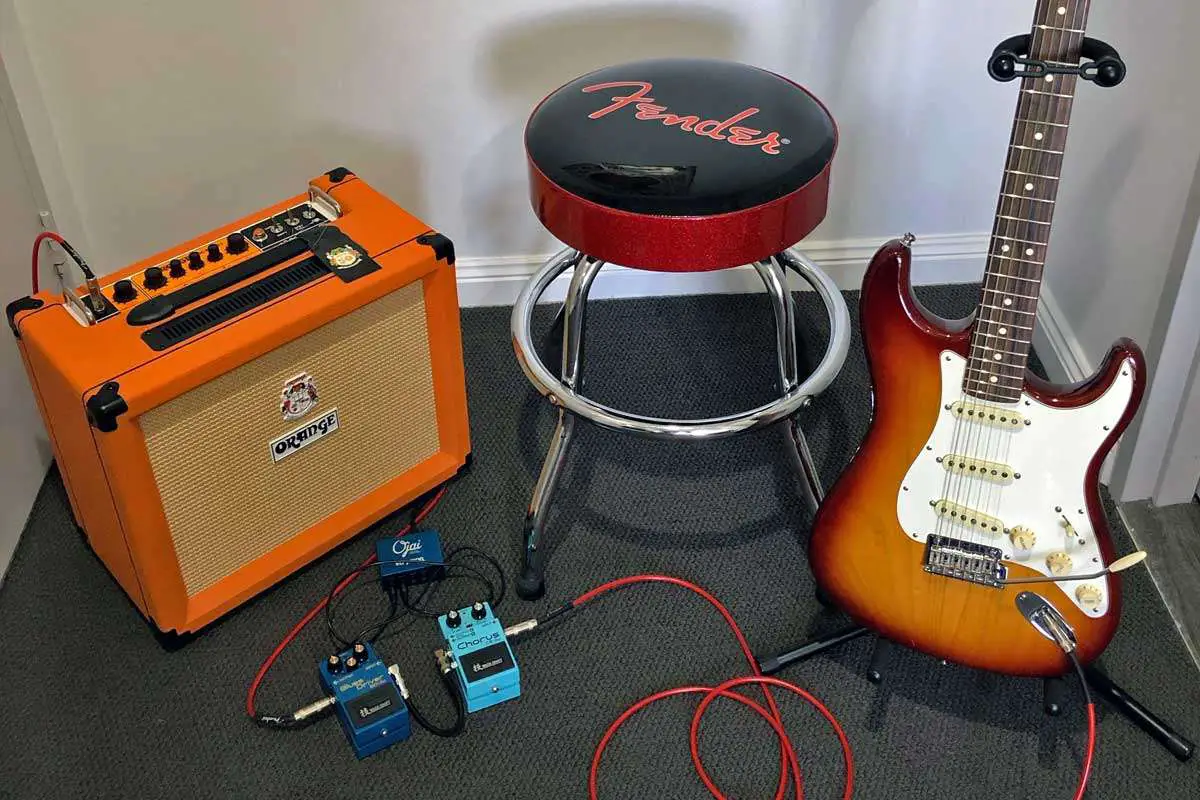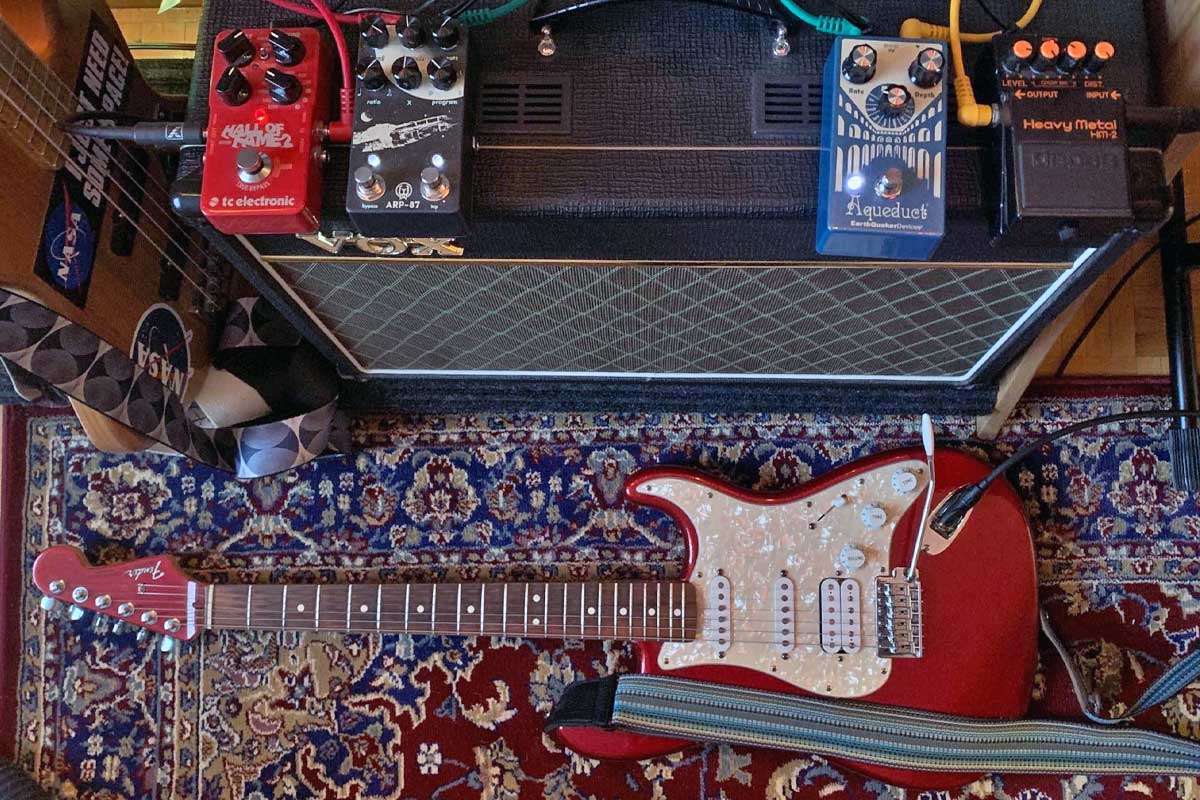Playing the electric guitar involves a combination of skill, artistry, and the right equipment – but what do you need to play an electric guitar as a hobby exactly? To get started, you simply need an electric guitar (of course), a guitar cable, and a guitar amplifier. These are fundamental for converting the vibrations of your guitar’s strings into audible sound. Once you have these basics, you’re ready to create music!
However, accessories can greatly enhance your playing experience. They’re not just about personal preference but also about practical needs. An extra set of guitar strings is crucial for dealing with unexpected breakages & keeping your instrument sounding its best. Guitar picks allow for a more precise attack on the strings, affecting tone and playability. A guitar strap will enable you to play comfortably while standing, and to protect your instrument, investing in a guitar case or gig bag is wise.
Key Takeaways
- The essentials for electric guitar playing are the guitar itself, an instrument cable, and an amplifier.
- Practical accessories include extra strings, guitar picks, and a guitar strap.
- Protecting your guitar with a case or gig bag is also highly recommended and helps with transporting your instrument.

Equipment Essentials For Electric Guitar
When setting out to play the electric guitar, there are two items that are absolutely crucial for both your sound and your overall playing experience. You’ll want to consider the specifics of the guitar & amplifier, as these two foundational pieces will greatly influence your tone and style.
Choosing Your Electric Guitar
Body: Electric guitars come in various body shapes and sizes. The solid-body design of a Stratocaster is renowned for its comfortable contouring and versatility across genres. The Les Paul, with its thicker body and warm tone, is iconic in rock and blues. A Telecaster offers a more twangy and crisp sound. This is all down to preference and the aesthetic you like best!
Related: A list of the top guitar brands
Neck and Feel: The neck of the guitar contributes to playability. You should examine the size and shape to ensure it fits comfortably in your hand.
Pickups: Pickups are essential for sound. Stratocasters often come with single-coil pickups, providing a bright, clear tone. Les Paul guitars, on the other hand, are equipped with humbuckers that offer a fuller, richer sound with less hum. There’s even guitars that have the best of both worlds, single coils for a twangy clean sound & humbuckers for maximizing distortion & rocking out.
Brand and Price: Your choice might be influenced by brand reputation and price. Brands like Fender, Gibson, and Ibanez are known for quality, but also consider budget guitars such as Epiphone, Squier, and many others as long as the brand aligns with the style of music you play.
Here’s a few of the electric guitars for beginners that we recommend. They are accessible across many price points and offer a decent value for most new players: Best Electric Guitar for Beginners: Top Picks for New Players
Amplifiers & Tone Shaping
Amplifiers: Your choice of amplifier will greatly affect your electric guitar’s sound. Tube amplifiers are celebrated for their warm, full tone and natural overdrive, while solid-state amps are reliable and generally have a crisper sound profile. For beginners, we recommend trying out a solid-state amp known as a modeling amp which is a type of amplifier that allows you to try out multiple styles of sound.
These modeling amps are different than Tube or Valve amps, which typically only offer a single flavor of sound and require additional effects pedals to fine-tune your guitar tone to your exact specifications.
Size & Speakers: We recommend a combo amp, which is an amplifier with built-in speakers as opposed to an amp head & cab. The size of the amp & its speakers will influence the volume and type of sound it can produce and something with a 12″ or even 10″ speaker is sufficient for most practice sessions.
Tone and Effects: Look for features like reverb, distortion, and tone controls to shape your overall sound. Practice amps are a great starting point due to their portability and often include a variety of built-in effects.
For starters, we recommend you check out these practice guitar amps that are beginner friendly. Also with advancing technology, there is also the option of going with a headphone amplifier which can help tremendously when you want to practice quietly anytime and not disturb others. Both options offer many tonal variety & effects – Here are the best headphone amplifiers we recommend with the Positive Grid “Spark Go” as our personal favorite.
Essential Accessories & Add-ons
To get the most out of your electric guitar playing experience, equipping yourself with the right accessories is something to consider. They not only enhance the playability and sound of your instrument but also ensure its longevity and maintenance.
Guitar Support & Maintenance
Guitar Stands and Cases:
- To protect your guitar from accidents when you’re not playing, you’ll need a reliable guitar stand or a secure case. Choices range from a simple stand to more protective hard cases or padded gig bags.
- Guitar Maintenance Equipment:
- Regular cleaning and maintenance ensure your guitar lasts a lifetime. This includes string winders for quick string changes, and maintenance kits for polishing and cleaning your guitar.
Tuning and Sound Enhancement
Tuners and Metronomes:
- A precise guitar tuner is indispensable. Options include clip-on tuners and pedal tuners which offer convenience and accuracy.
- Metronomes keep you in time, either through a standalone device or an integrated feature in a tuner.
Cables:
- High-quality guitar cables are essential to transfer your guitar’s sound to the amplifier without any interference or noise.
Playing Aids and Technique Tools
Capos and Slides:
- A capo can radically change the tone of your guitar, allowing you to play in different keys without changing your fingering technique.
- Slides are cylindrical devices that you place on one of your fingers to create a smooth, sustained sound typified in blues music.
Picks and Straps:
- Picks, or plectrums, come in various sizes and materials, each offering a different response and feel. Finding your preferred pick is a matter of personal taste.
- Secure your guitar with a sturdy guitar strap fastened by reliable strap locks to avoid the instrument falling while playing.
Mastering chords, riffs, and licks are an integral part of electric guitar playing. With these essential accessories and add-ons, you’ll be well on your way to expressing your musical creativity and techniques.
Enhancing The Electric Guitar Experience
To truly elevate your playing, you’ll need to go beyond the basics. Your electric guitar’s potential can be unleashed through the use of various accessories and customization, shaping not just the instrument’s sound, but also its playability to suit your unique style.

Effects, Pedals, and Sound Exploration
Pedals are the gateway to sonic diversity, enabling you to push the boundaries of genre and create your own signature sound. From budget-friendly options to high-end gear, effects pedals like distortion, reverb, and delay are fundamental for any musician looking to enhance their playing experience. Whether you are delving into the realm of metal with a heavy distortion pedal or creating ambient soundscapes with a reverb pedal, these tools can significantly expand your sonic palette.
- Distortion Pedals: Achieve the gritty, aggressive tone favored in rock and metal. Here’s some distortion pedals we recommend.
- Reverb Pedals: Add depth and space to your sound, essential for creating atmosphere in genres like jazz or blues. Here’s some reverb pedals we recommend.
- Delay Pedals: Experiment with echoes and time-based effects to add complexity to your playing. Here’s some delay pedals we recommend.
Customizing Guitar Playability and Style
Customizing your electric guitar is as much about improving playability as it is about personalizing the instrument’s looks. Consider the strap, body shape, and fretboard – these elements should align with your physical comfort and playing style. Adjusting string action or swapping out pickups can also dramatically affect how your guitar feels and responds.
- Strap: Choose a strap that offers comfort and stability, vital for lengthy playing sessions.
- Body Shape and Fretboard: Opt for a shape and neck profile that fits your hands and playing technique.
- Pickups: A high-gauge pickup might better suit heavier music, while a single-coil could be preferable for crisp, clean tones typical in jazz.
Your electric guitar is not just an instrument—it’s a platform to express your musicality. By exploring effects, pedals, and customization, you can adapt your guitar precisely to your skill level and genre, ensuring a more enjoyable and rewarding playing experience.
